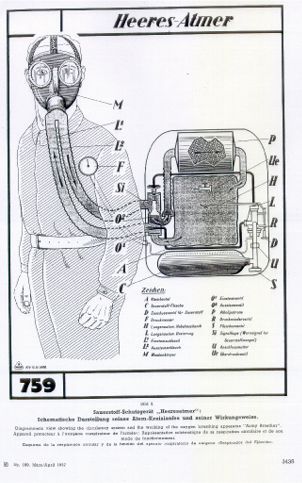|
|
||||||
DATASHEET OXYGEN REBREATHER |
||||||
Dräger HEERESATMER (KG120) |
Date:
16 June 2002 |
|||||
“ARMY BREATHER” not for underwater purposes
(SCBA)
|
JW. Bech
|
|||||
|
Manufacturer
|
Dräger
|
1937 |
||||
|
Model |
LAR VI |
|
||||
|
Land of origin |
Germany |
|
||||
|
Special Note: |
Deutsche
Civilen Luftschutzes |
|
||||
|
User group |
Military |
|
||||
|
Part no: |
Draegerwerk 759 |
|
||||
|
Working
principle |
Constant Mass Flow |
1,5 ltr/min |
||||
|
Gas
type |
Oxygen 100% |
|
||||
|
Cylinder
volume |
1 liter |
|
||||
|
Max.
cylinder pressure |
150
bar |
IP 3
bar |
||||
|
Material
of cylinder |
steel |
|
||||
|
Counterlung
inspire |
5.5 liter |
|
||||
|
Counterlung
exhale |
- |
|
||||
|
Dive
time duration |
1 hour |
|
||||
|
Operating
temperature |
Not specified |
|
||||
|
Magnetic
signature |
|
|
||||
|
Weight
ready to use in Air |
|
|
||||
|
Weight
ready to use in water |
- |
|
||||
|
MOD
|
Land operations only |
|
||||
|
Scrubber
material |
Alkali (Bariumhydroxid?) |
|
||||
|
Colour
|
Black |
|
||||
|
Price
|
|
|
||||
|
Worn
|
|
|
||||
|
Mouthpiece
|
No on/off valve |
|
||||
|
Backpack
|
|
|
||||
|
Extra
|
“Seitenschlauchgerat” |
|
||||
|
Extra
|
Fullface
mask |
|||||
|
|
|
|||||
|
|
|
|||||
|
Bypass
by means of lever directly connected to counterlung (fysical), operating
bypass valve for extra oxygen supply! Surplus; Manual Bypass button
operated.Also there is a acoustic warning signal when the oxygen bottle is
not opened! |
|
|||||
|
|
||||||
|
If
you have any information to add this sheet please mail it to jw.bech@quicknet.nl
References to source and names will always be added! |
|
|||||
|
Info
found: |
|
|||||
|
Origin:
http://www.therebreathersite.nl
|
|
|||||
|
Info:
I have a PDF file on the unit. Please send an email and I will inform you |
|
|||||
|
|
|
|||||
|
||||||

